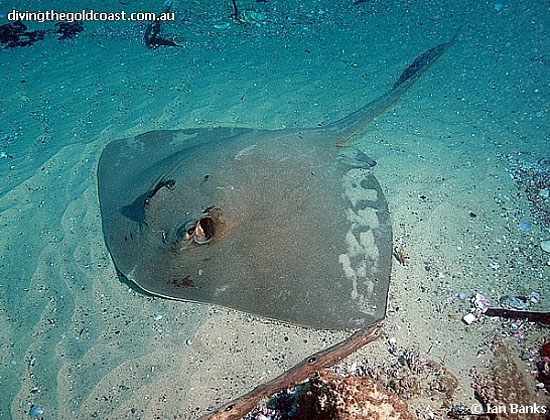
|
Pastinachus sephen (Fabricius, 1775) Cowtail stingray |
||
| Feathertail stingray, ௭ல்த்தீருக்கை, Adal-thirikkai, Adathirukkai, Adavalan-tiriki, Athuthirukkai, Drab stingray, Elathirukkai, Frill tailed sting ray, Goval-pakat, Kottar-thorake, Kottivalen-therandi, Madi, Olaival thirukkai, Olapadayan thirandi, Olavalan-thirandi, Padaiyan-therandee, Puzhian-thirukkai, Sting ray, Velugiri-tenkee, Wolga-tenkee, गोवळ, गोवळ पकात, पकात, அடதீருக்கை, அடல் தீருக்கை, அடவலன் தீருக்கை, அதவாழன் திருக்கை, ஆத திருக்கை, ஆதல் திருக்கை, இலை திருக்கை, உலைவல் தீருக்கை , ஓலைவால் திருக்கை, வோல்க டென்கீ , వెలుగిరి టెంకీ , వెలుగిరి టెంకీ , వోల్గా టెంకీ, ಕೊಟ್ಟರ್ ತೊರಕೆ, അതുതിരുക്കൈ, ആറ്റുതിരുത, ആള്പിടിയന് തിരണ്ടി, ഒലപടയന് തിരണ്ടി, ഒലവലന് തിരണ്ടി, ഓല വാലന് തിരണ്ടി, കൊട്ടിവേലന് തിരണ്ടി , കൊറ്റിവാലന് തിരണ്ടി, പടിയന് തിരണ്ടി , പടിയന് തിരണ്ടി , പടിയന് തെരണ്ടി, പുഴിയന് തിരുക്കെ, പുഴിയന് തിരുക്കൈ, Cowtail ray, Shankar-machh | ||

|
|
photo by
Banks, I. |
| Family: | Dasyatidae (Stingrays), subfamily: Hypolophinae | |||
| Max. size: | 183 cm WD (male/unsexed) | |||
| Environment: | reef-associated; freshwater; brackish; marine; depth range 0 - 60 m, amphidromous | |||
| Distribution: | Northwestern Indian Ocean: Red Sea to Pakistan. | |||
| Diagnosis: | Dorsal spines (total): 0-0; Dorsal soft rays (total): 0-0. A large, plain, dark stingray with an angular snout and pectoral disc; tail long and broad-based, less than twice body length, and with no upper caudal finfold but with high lower caudal finfold- 2 to 3 times depth of tail but not reaching tail tip; no large thorns; 1 or 2 long stings on tail, further behind tail base than in most stingrays; unique hexagonal, high-crowned teeth (Ref. 5578). Dark brown or black dorsally without conspicuous markings, white ventrally (Ref. 5578). Tail black (Ref. 3263). | |||
| Biology: | Found in lagoons, reef flats, and reef faces (Ref. 12951). Also in rivers far from the sea (Ref. 5578). Feeds on bony fishes, worms, shrimp, and crabs (Ref. 12951). Ovoviviparous (Ref. 50449). Adults are sometimes accompanied by remoras or members of the trevally family (Ref. 6871). Size at birth about 18 cm WD or larger (Ref. 6871). Flesh utilized as food and skin used for polishing wood (Ref. 4832). Possibly caught by sports anglers (Ref. 5578). Recently there is a targeted fishery on this species for its skin, which is used as 'shagreen' in fashion accessories, from wallets to fancy pens; as a result, the species is in danger of disappearance (IHT 26.11.2005, p.5). Maximum length about 300 cm TL (Ref. 30573). | |||
| IUCN Red List Status: | Near Threatened (NT); Date assessed: 07 February 2017 (A2d+3d) Ref. (130435) | |||
| Threat to humans: | venomous | |||
| Country info: | Found in Palk Bay and Gulf of Mannar; also in coastal waters and Chilka Lake (Ref. 45255); Andaman and Nicobar Islands (Ref. 118627). It has been erroneously reported from freshwater in the Ganges river (Ref. 4832). Reported to breed after the monsoon season in Cuddalore (Ref. 27550). Taken by large number of poor people. Its tail is populatry used as whip by the villagers. Large sized (Ref. 33273). Also Ref. 29108, 33178. | |||